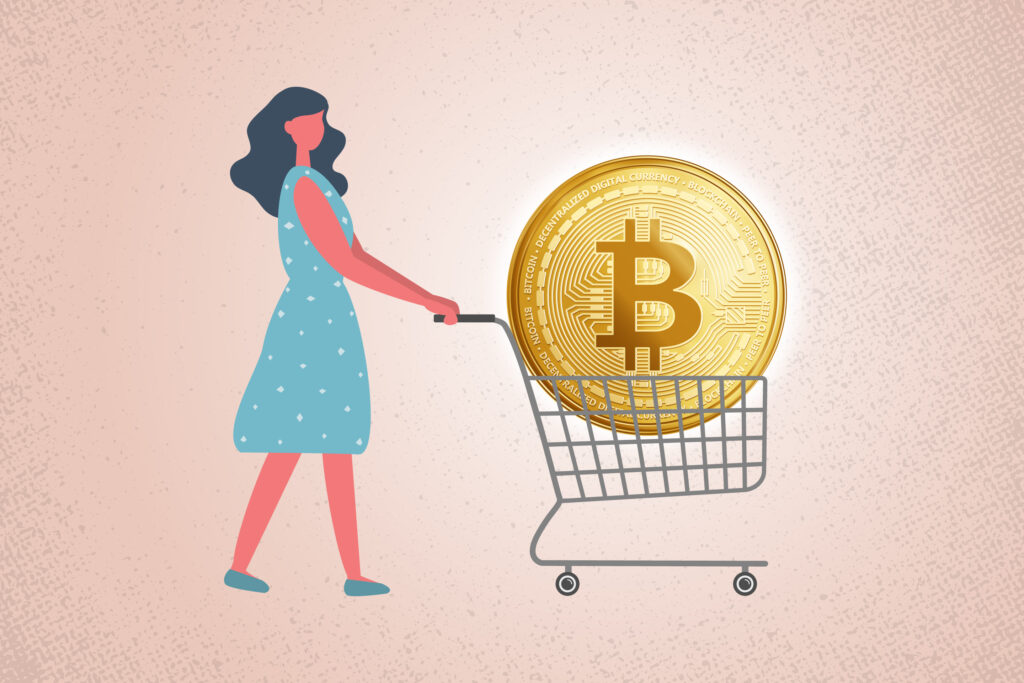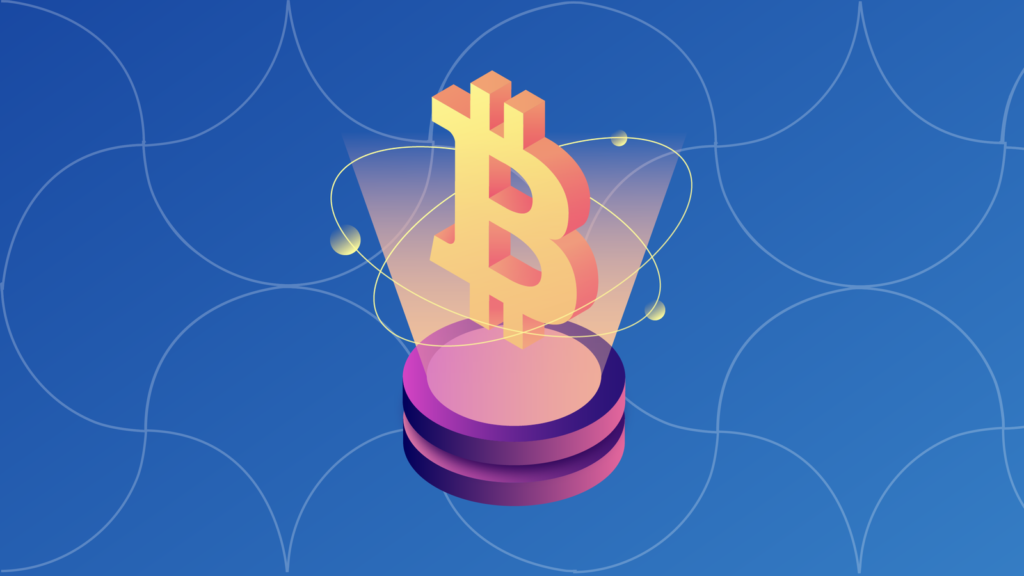Bitcoin for Beginners: Bitcoin (BTC) is a cryptocurrency, a virtual currency designed to act as money and a form of payment outside the control of any one person, group, or entity, thus removing the need for third-party involvement in financial transactions. It is rewarded to blockchain miners for the work done to verify transactions and can be purchased on several exchanges.

Bitcoin for Beginners
Bitcoin was introduced to the public in 2009 by an anonymous developer or group of developers using the name Satoshi Nakamoto. It has since become the most well-known cryptocurrency in the world. Its popularity has inspired the development of many other cryptocurrencies. These competitors either attempt to replace it as a payment system or are used as utility or security tokens in other blockchains and emerging financial technologies.
Bitcoin’s origin, early growth, and evolution
Bitcoin’s origin
Bitcoin for Beginners: Bitcoin is based on the ideas laid out in a 2008 whitepaper titled Bitcoin: A Peer-to-Peer Electronic Cash System. The paper detailed methods for “allowing any two willing parties to transact directly with each other without the need for a trusted third party.” The technologies deployed solved the ‘double spend’ problem, enabling scarcity in the digital environment for the first time. The listed author of the paper is Satoshi Nakamoto, a presumed pseudonym for a person or group whose true identity remains a mystery. Nakamoto released the first open-source Bitcoin software client on January 9th, 2009, and anyone who installed the client could begin using Bitcoin.

Bitcoin’s early growth
Bitcoin for Beginners: The initial growth of the Bitcoin network was driven primarily by its utility as a novel method for transacting value in the digital world. Early proponents were, by and large, ‘cypherpunks’ – individuals who advocated the use of strong cryptography and privacy-enhancing technologies as a route to social and political change. However, speculation as to the future value of Bitcoin soon became a significant driver of adoption.
Bitcoin’s evolution
Bitcoin for Beginners: The price of bitcoin and the number of Bitcoin users rose in waves over the following decade. As regulators in major economies provided clarity on the legality of Bitcoin and other cryptocurrencies, a large number of Bitcoin exchanges established banking connections, making it easy to convert local currency to and from bitcoin. Other businesses established robust custodial services, making it easier for institutional investors to gain exposure to the asset as a growing number of high-profile investors signaled their interest.
Bitcoin working
Bitcoin for Beginners: Each Bitcoin is a digital asset that can be stored at a cryptocurrency exchange or in a digital wallet. Each individual coin represents the value of Bitcoin’s current price, but you can also own partial shares of each coin. The smallest denomination of each Bitcoin is called a Satoshi, sharing its name with Bitcoin’s creator. Each Satoshi is equivalent to a hundred millionth of one Bitcoin, so owning fractional shares of Bitcoin is quite common.

Balances – Blockchain
Bitcoin for Beginners: The blockchain is a shared public ledger on which the entire Bitcoin network relies. All confirmed transactions are included in the blockchain. It allows Bitcoin wallets to calculate their spendable balance so that new transactions can be verified thereby ensuring they’re actually owned by the spender. The integrity and the chronological order of the blockchain are enforced with cryptography.
Transactions – Public and Private keys
Bitcoin for Beginners: A transaction is a transfer of value between Bitcoin wallets that gets included in the blockchain. Bitcoin wallets keep a secret piece of data called a private key or seed, which is used to sign transactions, providing a mathematical proof that they have come from the owner of the wallet. The signature also prevents the transaction from being altered by anybody once it has been issued. All transactions are broadcast to the network and usually begin to be confirmed within 10-20 minutes, through a process called mining.
Processing – Bitcoin Mining
Bitcoin for Beginners: Mining is a distributed consensus system that is used to confirm pending transactions by including them in the blockchain. It enforces a chronological order in the blockchain, protects the neutrality of the network, and allows different computers to agree on the state of the system. To be confirmed, transactions must be packed in a block that fits very strict cryptographic rules that will be verified by the network. These rules prevent previous blocks from being modified because doing so would invalidate all the subsequent blocks. Mining also creates the equivalent of a competitive lottery that prevents any individual from easily adding new blocks consecutively to the blockchain.

Basic And Economic Features Of Bitcoin
Bitcoin’s basic features
Decentralized
Bitcoin’s basic features: Nobody controls or owns the Bitcoin network, and there is no CEO. Instead, the network consists of willing participants who agree to the rules of a protocol. Changes to the protocol must be made by the consensus of its users and there is a wide array of contributing voices including ‘nodes,’ end users, developers, ‘miners,’ and adjacent industry participants like exchanges, wallet providers, and custodians. This makes Bitcoin a quasi-political system. Of the thousands of cryptocurrencies in existence, Bitcoin is arguably the most decentralized, an attribute that is considered to strengthen its position as pristine collateral for the global economy.
Distributed
Bitcoin’s basic features: All Bitcoin transactions are recorded on a public ledger that has come to be known as the ‘blockchain.’ The network relies on people voluntarily storing copies of the ledger and running the Bitcoin protocol software. These ‘nodes’ contribute to the correct propagation of transactions across the network by following the rules of the protocol as defined by the software client. There are currently more than 80,000 nodes distributed globally, making it next to impossible for the network to suffer downtime or lost information.

Transparent
Bitcoin’s basic features: The addition of new transactions to the blockchain ledger and the state of the Bitcoin network at any given time is arrived upon by consensus and in a transparent manner according to the rules of the protocol.
Peer-to-peer
Bitcoin’s basic features: Although nodes store and propagate the state of the network, payments effectively go directly from one person or business to another. This means there’s no need for any ‘trusted third party’ to act as an intermediary.
Permissionless
Bitcoin’s basic features: Anyone can use Bitcoin, there are no gatekeepers, and there is no need to create a ‘Bitcoin account.’ Any and all transactions that follow the rules of the protocol will be confirmed by the network along the defined consensus mechanisms.
Pseudo-anonymous
Bitcoin’s basic features: Identity information isn’t inherently tied to Bitcoin transactions. Instead, transactions are tied to addresses that take the form of randomly generated alphanumeric strings.

Censorship resistant
Bitcoin’s basic features: Since all Bitcoin transactions that follow the rules of the protocol are valid, since transactions are pseudo-anonymous, and since users themselves possess the ‘key’ to their bitcoin holdings, it is difficult for authorities to ban individuals from using it or to seize their assets. This carries important implications for economic freedom, and may even act as a counteracting force to authoritarianism globally.
Public
Bitcoin’s basic features: All Bitcoin transactions are recorded and publicly available for anyone to see. While this virtually eliminates the possibility of fraudulent transactions, it also makes it possible to, in some cases, tie by deduction individual identities to specific Bitcoin addresses. A number of efforts to enhance Bitcoin’s privacy are underway, but their integration into the protocol is ultimately subject to Bitcoin’s quasi-political governance process.
Bitcoin’s economic features
Fixed supply
Bitcoin’s economic features: One of the key parameters in the Bitcoin protocol is that the supply will expand over time to a final tally of 21 million coins. This fixed and known total supply, it is argued, makes Bitcoin a ‘hard asset,’ one of several characteristics that have contributed to its perceived value from an investment perspective.

Disinflationary
Bitcoin’s economic features: The rate at that new bitcoins are added to the circulating supply gradually decreases along a defined schedule that is built into the code. Starting at 50 bitcoins per block, the issuance rate is cut in half approximately every four years. In May 2020, the third halving reduced the issuance rate from 12.5 to 6.25 bitcoins per block. At that point 18,375,000 of the 21 million coins had been ‘mined.’ The fourth halving, in 2024, will reduce the issuance to 3.125 BTC, and so on until approximately the year 2136, when the final halving will decrease the block reward to just 0.00000168 BTC.
Incentive driven
Bitcoin’s economic features: A core set of participants, known as miners, are driven by profit to contribute the resources needed to maintain and secure the network. Through a process known as Proof-of-Work, miners compete to add new blocks to the chain that constitutes the ledger. The hardware and energy costs associated with PoW mining contribute to the security of the network in a decentralized fashion along game-theory-driven principles. The profit motive is considered important in this regard. Further, since miners tend to sell their earned bitcoin to cover their significant mining-related costs, the mining process is seen as a fair mechanism for widely distributing bitcoin.

Bitcoin Uniqueness
Bitcoin’s most unique advantage comes from the fact that it was the very first cryptocurrency to appear on the market. It has managed to create a global community and give birth to an entirely new industry of millions of enthusiasts who create, invest in, trade, and use Bitcoin and other cryptocurrencies in their everyday lives. The emergence of the first cryptocurrency has created a conceptual and technological basis that subsequently inspired the development of thousands of competing projects.
Risks of Investing in Bitcoin
Speculative investors have been drawn to Bitcoin after its rapid price appreciation in recent years. Bitcoin had a price of $7,167.52 on Dec. 31, 2019, and a year later, it had appreciated more than 300% to $28,984.98. It continued to surge in the first half of 2021, trading at a record high of $68,990 in November 2021 it then fell over the next few months to hover around $40,000. As mentioned above, in early 2022, the price started to drop and has continued to do so for most of 2022.
Thus, many people purchase Bitcoin for its investment value rather than its ability to act as a medium of exchange. However, the lack of guaranteed value and its digital nature means its purchase and use carry several inherent risks. For example, many investor alerts have been issued by the Securities and Exchange Commission, the Financial Industry Regulatory Authority (FINRA), and the Consumer Financial Protection Bureau regarding Bitcoin investing.

Regulatory risk
Risks of Investing in Bitcoin: The lack of uniform regulations regarding Bitcoin raises questions over its longevity, liquidity, and universality.
Security risk
Risks of Investing in Bitcoin: Most individuals who own and use Bitcoin have not acquired their tokens through mining operations. Rather, they buy and sell Bitcoin and other digital currencies on popular online markets, known as cryptocurrency exchanges. Bitcoin exchanges are entirely digital and as with any virtual system are at risk from hackers, malware, and operational glitches.
Insurance risk
Risks of Investing in Bitcoin: Bitcoin and cryptocurrencies are not insured through the Securities Investor Protection Corporation or the Federal Deposit Insurance Corporation. Some exchanges provide insurance through third parties. In 2019, prime dealer and trading platform SFOX announced it would be able to offer Bitcoin investors FDIC insurance, but only for the portion of transactions involving cash.
Fraud risk
Risks of Investing in Bitcoin: Even with the security measures inherent within a blockchain, there are still opportunities for fraudulent activity. For instance, in July 2013, the SEC brought legal action against an operator of a Bitcoin-related Ponzi scheme.
Market risk
As with any investment, Bitcoin values can fluctuate. Indeed, the value of the currency has seen wild swings in price over its short existence. Subject to high-volume buying and selling on exchanges, it is highly sensitive to any newsworthy events. According to the CFPB, the price of Bitcoin fell by 61% in a single day in 2013, while the one-day price drop record in 2014 was as big as 80%.

Bitcoin Pros And Cons
Bitcoin pros
Cost-efficient transactions and fast speeds
Bitcoin Pros And Cons: Once you own Bitcoin, you can make transfers anytime, anywhere, reducing the time and potential expense of any transaction.
Privacy
Bitcoin Pros And Cons: Transactions don’t contain personal information, such as a name or credit card number. While it’s still possible to link a certain person to a certain wallet, transactions are generally more private than credit card transactions, for example.
Decentralization
Bitcoin Pros And Cons: After the financial crisis and the Great Recession, some investors are eager to embrace an alternative, decentralized currency one that is essentially outside the control of regular banks, governing authorities, or other third parties.
Growth potential
Bitcoin Pros And Cons: Some investors who buy and hold the currency are betting that once Bitcoin matures, greater trust and more widespread use will follow, and therefore Bitcoin’s value will grow.

Bitcoin cons
Price volatility
Bitcoin Pros And Cons: While Bitcoin’s value has risen dramatically over the years, buyers’ fortunes have varied widely depending on the timing of their investment. Those who bought in 2017 when Bitcoin’s price was racing toward $20,000, for example, had to wait until December 2020 to recover their losses. More recently, Bitcoin’s price began in 2022 at slightly over $47,000 per coin. After a tough year for cryptocurrency in general, Bitcoin has slumped to its current price of just under $17,000.
Hacking concerns
Bitcoin Pros And Cons: While backers say the blockchain technology behind Bitcoin is even more secure than traditional electronic money transfers, there have been a number of high-profile hacks. In May 2019, for instance, more than $40 million in Bitcoin was stolen from several high-net-worth accounts on the cryptocurrency exchange Binance.
Not protected by SIPC
Bitcoin Pros And Cons: The Securities Investor Protection Corporation insures investors up to $500,000 if a brokerage fails or funds are stolen, but that insurance doesn’t cover cryptocurrency.

Check Also: Vitalik Buterin Net Worth The Man Behind Crypto Bio In 2023
Frequently Asked Questions (Faqs)
What are the pros and cons of investing in Bitcoin?
The advantages of cryptocurrencies include cheaper and faster money transfers and decentralized systems that do not collapse at a single point of failure.
What beginners should know about Bitcoins?
Bitcoin is a form of digital currency that aims to eliminate the need for central authorities such as banks or governments.
Should a beginner invest in Bitcoin?
Cryptocurrency is a highly speculative area of the market, and many smart investors have decided to put their money elsewhere.
What is the starting point of Bitcoin?
On 3 January 2009, the bitcoin network was created when Nakamoto mined the starting block of the chain, known as the genesis block.
How Safe Is Bitcoin investment?
No. Bitcoin is a particularly risky investment with more volatility than traditional investments of stocks, bonds and funds.
